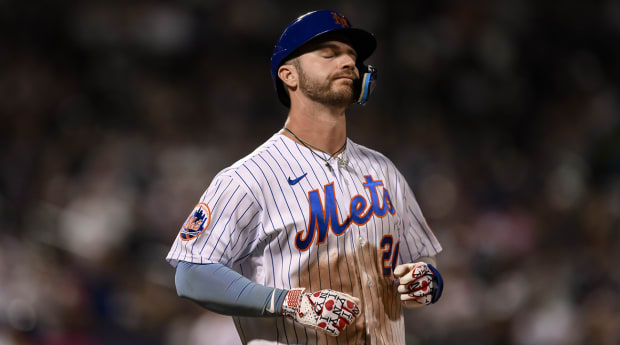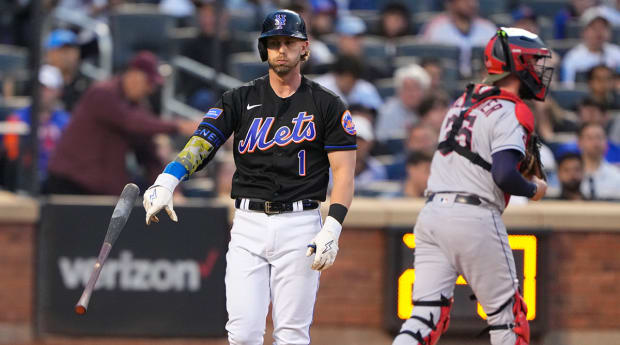Coming off 101 wins and carrying the highest payroll in baseball, the 52–62 Mets (going into games on August 11) qualify as the biggest bust in baseball.
“You could have spelled out all different scenarios to me when this season began,” says one Met. “Contend, win it all, come up a little short ... but this? Being out of it with two months to go? No way. No way that was possible.”
The fall of the Mets is so great it could end up being one of the biggest collapses of a 100-win team in the game’s history. According to the Elias Sports Bureau, only three teams posted a losing record in a full season after winning 100 games.

John Jones/USA TODAY Sports
(Three teams posted losing records in shortened seasons after winning 100: the 1918 White Sox, ’94 Giants and 2020 Astros.)
New York must finish at least 29–19 to avoid a losing record and joining this ignoble list—when great teams go bad.
1932 Cardinals (72–82, -29 wins from previous season)
Why they fell: Bad trades.
The defense of their World Series title went horribly wrong. St. Louis finished tied for sixth in an eight-team league, 18 games behind the first-place Cubs. In the waning moments of the season, owner Sam Breadon not only gave a pass to general manager Branch Rickey but also gave him a contract extension.
Breadon said while some people might point to Rickey’s trades of Burleigh Grimes, Chick Hafey and Flint Rhem as the reason for the Cardinals’ backsliding, he dismissed that notion and instead said, “Injuries to all of our regular players simply wrecked our club.”
Rickey, perhaps operating under budget constraints, fared poorly in his deals. First, he traded Grimes, a 17-game winner and future Hall of Fame pitcher, to the Cubs for Hack Wilson, who was coming off a down season after his 191-RBI monster year in 1930.
Rickey then offered Wilson a 77% pay cut, from $33,000 to $7,500. Wilson was willing to accept a 50% pay cut. But Rickey held firm. He then flipped Wilson to the Dodgers for Bob Parham, a minor leaguer who never played in the majors.
Hafey was the Cardinals’ longtime left fielder who led the world champion 1931 Cardinals in home runs and RBIs. Hafey held out in a contract dispute for a second straight year. In ’31 he signed for $12,500 but had to pay $2,000 in fines for the holdout. Rickey first offered him the same salary in ’32, then tossed in a $500 raise and held firm. Hafey refused to sign. So Rickey traded him to Cincinnati for pitcher Benny Frey, utility player Harvey Hendrick and cash. Just one month later, Rickey sold Frey back to the Reds.
In June, Rickey sold Rhem, a starting pitcher, to the Boston Braves.
In sum, Rickey traded two starting pitchers and his leading bat off a World Series team and had virtually nothing to show for it. But, yeah, sure, blame it on injuries.
Rickey was, however, building his famous minor league system. The Cardinals would win the World Series again two years later.
1971 Reds (79–83, -23 wins)
Why they fell: Down years for players in their prime.
One September day at Dodger Stadium in 1971, Reds pitcher Lynn McGlothen was trying to pitch through a jam when the game was stopped by umpire Billy Williams because of a live chicken in right field. Just as everyone paid attention to the chicken, a 10-pound sack of flour fell from the sky and exploded near Cincinnati shortstop Woody Woodward. The sack apparently had been tossed from an airplane that nobody saw.
“I don’t drink much beer,” said a shaken Woodward, “but I’m gonna have me a couple tonight.”
Said McGlothen, “I’m surprised the flour didn’t hit me in the head. That’s the way I’m going.”
The Reds did win the game, 7–5, but loose chickens and flying sacks of flour hinted at the weirdness of the year. The Big Red Machine had arrived in 1970. The Reds won 102 games and the NL pennant with no pitcher and starting player older than 29. Players in their 20s accounted for 96.5% of the team’s plate appearances.
But many of their young stars had down years in 1971, including Tony Pérez (who lost 38 points off his OPS+), Johnny Bench (-34) and Dave Concepción (-26). Center fielder Bobby Tolan missed the season after tearing his Achilles playing pickup basketball. (But the Reds did trade for George Foster.) Pitcher Jim Merritt, whose elbow hurt so much he could not throw a fastball, sunk from 20–12 to 1–11.
The 1971 Reds started 20–32, falling 16½ games out after just 52 games. They were never in the race. They did return to the World Series the next year and won it three years after that.
1986 Cardinals (79–82, -22 wins)
Why they fell: Bad Karma.
You know the story. Don Denkinger missed a call at first base in Game 6 of the 1985 World Series, and the Cardinals collapsed, getting outscored 13–0 by Kansas City in the final 10 innings. Starting pitcher Joaquín Andújar, suspended 10 games for bumping Denkinger in an ugly Game 7, was traded to Oakland.
The Cardinals did start 1986 7–1 but went 9–26 in their next 35 games and got steamrolled by the Mets. They were cooked even before first baseman Jack Clark tore thumb ligaments June 26. (They played winning baseball after losing their one true slugger.)
After leading the league in runs in 1985, the Cardinals were last in runs, hits and homers in ’86. Like the ’71 Reds, they returned to the World Series the year after they stumbled—part of a seven-year stretch in which St. Louis weirdly alternated winning and losing seasons.

Gregory Fisher/USA TODAY Sports
2023 Mets (projected 74–88, -27 wins)
Why they fell: Their offense broke as the Mets bet on age.
The Mets returned eight regulars from a 101-win team—six of them 30 and older—and all of them are having worse years: Jeff McNeil (-63 OPS+), Starling Marte (-58), Daniel Vogelbach (-51), Mark Canha (-21), Brandon Nimmo (-17), Eduardo Escobar (-16), Pete Alonso (-15) and Francisco Lindor (-5).
When the Mets tried to inject some youth, third baseman Brett Baty flopped, although catcher Francisco Álvarez showed impressive power.
New York won last year with a diversified offense that relied on batting average. The hits simply stopped coming, especially for McNeil, the 2022 batting champion and an example of how they won last year. His average against fastballs has dropped from .317 to .249.
Here’s the short version of how the offense broke: from the most hits in the league to the fewest—even with more home runs.
Mets League Ranks
| 2022 | 2023 | |
|---|---|---|
Batting Average |
1 |
13 |
Hits |
1 |
15 |
OBP |
2 |
11 |
Runs per Game |
3 |
10 |
RISP |
4 |
14 |
Slugging |
5 |
10 |
Home Runs |
8 |
5 |
The Mets bet on age on the mound, too. They have used nine pitchers 34 and older and they have returned a 22–29 record. Owner Steve Cohen paid $88 million to get out from under his huge signings of starters Max Scherzer and Justin Verlander, who were good but not spectacular (15–9 with a 3.61 ERA).
Defense didn’t help, either. A middle-of-the-pack defensive team last year (16th in defensive runs saved), the Mets have posted a DFS of -25 in 2023, which is the fifth worst in baseball.
And if it seems like New York has played most of its games from behind, you’re not wrong. The Mets have been outscored 80–38 in the first inning—allowing the third-most runs in the opening inning while scoring the fewest.
Add it up and you get a historic fall. The good news for the Mets: The three previous record falls all were anomalous seasons. All three teams bounced back with winning seasons the next year, winning the pennant in that year or the next.







